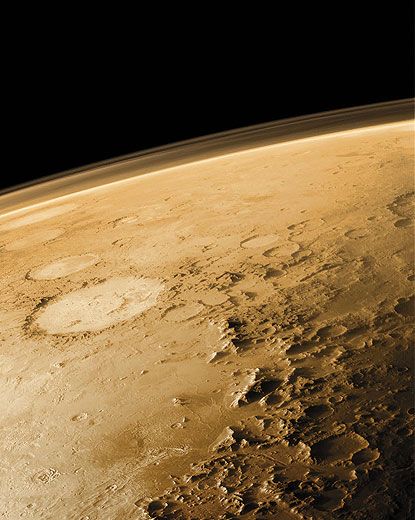Mars Mike
An elder statesman of space exploration wants pieces of Mars brought here.
/https://tf-cmsv2-smithsonianmag-media.s3.amazonaws.com/filer/MikeCarr631x300-FLASH.jpg)
Few scientists know Mars as well as Michael Carr, a planetary geologist at the U.S. Geological Survey from 1962 until his retirement in 2004. Carr, 77, who won the National Air and Space Museum’s lifetime achievement trophy in 1994, has influenced just about every NASA mission to Mars since Mariner 9 in 1971, for which he prepared the first global geologic maps of the planet. With co-author David Scott, Carr also showed how the history of Mars could be divided into three general periods, which are used to compare Martian geologic events and processes to those on other terrestrial planets. He is now an advisor to the Mars program office at NASA’s Jet Propulsion Laboratory in Pasadena, California. Author of more than 150 papers and two books on Mars, the native of Leeds, England, is known to colleagues as “Mars Mike,” a nickname he regards with amusement.
Air & Space: Are there other places in the solar system that deserve as much attention as has been paid to Mars?
Carr: I don’t believe so. The prospect of some form of indigenous life is driving the program, and while there are advocates for life elsewhere in the solar system, such as [Jupiter’s moon] Europa, I do think the prospects are best for Mars.
What sort of strategy would you recommend to explore Mars?
To me, sample return is the essence. Almost everybody involved agrees that what we need to do is get samples back from Mars. We have all this information on topography, surface hydrology, this and that, but the most outstanding unknown is: Is there any life on Mars or was there ever any life? And the only real way to determine that is to bring samples back to Earth and look at them with the most sophisticated instruments that we have.
How many samples would you need?
The mission that was being looked at was to have a rover and bring back on the order of 40 samples that were selected as the rover went around and did different kinds of sampling. We’re only talking about small amounts of material, about 500 grams total [about 1.1 pounds], selected from different locations. I think if there was life, that [information] could be determined from the samples.
More than half of all Mars missions have failed since the first flyby attempt by the Soviets in 1960. Why has Mars been so difficult to reach?
What you’re saying is somewhat deceptive, because if you look at U.S. missions we’ve been remarkably successful. We did have that bad spot [in 1999] when the Mars Polar Lander and the Mars Climate Orbiter failed. But we’ve been successful just one mission after another. And what we’re trying to do at Mars gets more and more difficult because we’ve done the easy things. The Russians have been very, very unsuccessful. Going to Mars, and particularly landing on Mars, is not easy.
Have the Russians given up trying to explore the planet?
They did try recently with the Phobos mission [a failed 2011 attempt to return a sample from the Martian moon Phobos]. I don’t know what the consequences are of their failures, but I suspect they’re having trouble getting their Mars program funded because of the failures. Now we’re getting our program cut despite having success.
What are your thoughts on the White House’s proposal to cut NASA’s budget for Mars exploration?
I’ve spent most of my life, since 1959, studying Mars, so obviously I’m very disappointed. And it’s disappointing too because the program has been so incredibly successful, and Mars is such an interesting place.
The Mars rovers have been getting progressively bigger. How big can rovers realistically get?
I suspect that the MSL [Mars Science Laboratory] is about as big as a robotic rover can get. What’s driving the size? It’s partly the payload, and the power required, and that kind of thing. There is a reason for size. If you’re an ant, it’s hard to get over a big boulder. If you want a rover to last a long time and be able to move over different kinds of terrain, size helps. But as time progresses, the instrumentation get smaller and smaller, so you don’t need as big a rover. Until people go and we have to lug people around, the MSL is about as big as rovers are going to get.
When do you think humans will go?
Certainly not in my lifetime. Maybe 2040 or 2050. There are various studies that are done and just to constrain the study, they have to pick a date. But it’s not a real date. Most of these are looking at 2030, but I don’t think it’s going to happen then.
Why not?
Here we are in 2012. I can’t believe that 20 years from now humans could be ready to go. The lead time to do something like that is just enormous. And there may be things you can’t speed up, like human factors, the physiological things that we don’t fully understand. A human mission to Mars is a very extended mission. You’re talking about 1,000 days. A lot of stuff has to be solved before you can do that.
Can we learn all we need to know without sending humans there?
Absolutely, as long as we have sample returns. Multiple rover missions with sample returns could adequately explore the planet and at far less expense than sending humans.
You’ve worked on a lot of Mars missions. Do you have a favorite?
I had a much bigger responsibility for Viking, so I was sort of much more deeply and emotionally involved with that one. I had a central role as leader of the Viking orbiter imaging team. I was young and enthusiastic. We worked long days, but I was so excited, I was sleeping in the office at JPL. For me, that was a special time.
What was the proudest moment for the Viking team? And how have other projects built on its foundation?
The proudest moment was undoubtedly the successful landing. This was the first successful landing on Mars. Everything had to go right, and there was that communications gap during descent. So when there were indications of success and the first pictures came in, that was a special moment. As for building on that success, much of the technology used in subsequent landed missions is Viking-derived.
What stands out as a key difference in the way missions are run today?
The data gets distributed so much more efficiently. On Viking, we had to store everything on tape and we made hard copies and photographs that were then distributed to the team members. There wasn’t the computer distribution network then that there is now. That’s a huge difference. I’ve been involved with a German camera [for Mars] and I can get the data here in my office just as well as someone sitting in Berlin.
What’s been the biggest surprise about Mars?
The initial recognition that water played such a prominent role in sculpting the surface. That goes back a long way [to Mariner 9 in 1972] and that was absolutely a total surprise. Along that same theme, a major surprise was when Opportunity landed [in 2004] and saw that outcrop of hydrated salts just next to it. That was kind of amazing. All this data that’s come back now about water ice, all these hydrated minerals, it just keeps coming. We see deltas, embedded sediments, lake sediments, evidence for the whole hydrological cycle. It’s a very exciting planet.
How much remains unknown?
Life is absolutely the central question, and there are two aspects to that. Did it ever start, and is it there now? The probability is much higher that it could have started very early and perhaps survived for a time. But the probability that there is present-day life has got to be much less because the surface is pretty hostile. From a scientific point of view, that’s what’s driving the program. That’s why we’ve got to have these samples back on Earth and look for details of any organics.
Paul Hoversten is the Air & Space executive editor.

